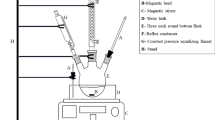Abstract
The oxidative stability of oils is a complex process influenced by several factors, making the evaluation of antioxidant effects of new compounds difficult. Thus, the objective of this study was to apply a factorial design to obtain the combination of factors that maximizes the formation of oil oxidation products, and use this model to evaluate the antioxidant activity of different compounds. Temperature, Fe2+ and ascorbyl palmitate were evaluated in two full-factorial designs (23 and 32). The validated optimized oxidation model was obtained by adding 1.47 mmol/L of Fe2+ and 1.54 mmol/L of ascorbyl palmitate to flaxseed oil stripped of tocopherol kept at 40 °C for 8 days. Antioxidant activities of six compounds were evaluated using this model. All antioxidant samples were statistically different (p < 0.001) at 200 ppm concentration, indicating the efficiency of the optimized model to evaluate the antioxidant action of natural and synthetic compounds.



Similar content being viewed by others
References
Zhang Y, Yang L, Zu Y, Chen K, Wang F, Liu F (2010) Oxidative stability of sunflower oil supplemented with carnosic acid compared with synthetic antioxidants during accelerated storage. Food Chem 118:656–662
Choe E, Min DB (2006) Mechanisms and factors for edible oil oxidation. Compr Rev Food Sci Food Saf 5:169–186
Kubow S (1992) Routes of formation and toxic consequences of lipid oxidation products in foods. Free Radic Biol Med 12:63–81
McClements DJ, Decker EA (2000) Lipid oxidation in oil-in-water emulsions: impact of molecular environment on chemical reactions in heterogeneous food systems. J Food Sci 65:1270–1282
Bera D, Lahir D, Nag A (2006) Studies on a natural antioxidant for stabilization of edible oil and comparison with synthetic antioxidants. J Food Eng 74:542–545
Soubra L, Sarkis D, Hilan C, Verger P (2007) Dietary exposure of children and teenagers to benzoates, sulphites, butylhydroxyanisol (BHA) and butylhydroxytoluene (BHT) in Beirut(Lebanon). Regul Toxicol Pharm 47:68–77
Maqsood S, Benjakul S (2010) Comparative studies of four different phenolic compounds on in vitro antioxidative activity and the preventive effect on lipid oxidation of fish oil emulsion and fish mince. Food Chem 119:123–132
Capitani CD, Carvalho ACL, Botelho PB, Carrapeiro MM, Castro IA (2009) Synergism on antioxidant activity between natural compounds optimized by response surface methodology. Eur J Lipid Sci Technol 111:1100–1110
Frankel EN, Finley JW (2008) How to standardize the multiplicity of methods to evaluate natural antioxidants. J Agric Food Chem 56:4901–4908
Laguerre M, Lecomte J, Villeneuve P (2007) Evaluation of the ability of antioxidants to counteract lipid oxidation: Existing methods, new trends and challenges. Progr Lipid Res 46:244–282
Niki E (2010) Assessment of antioxidant capacity in vitro and in vivo. Free Radic Biol Med 49:503–515
Choo W-S, Birch J, Dufour J-P (2007) Physicochemical and quality characteristics of cold-pressed flaxseed oils. J Food Compos Anal 20:202–211
Khan MA, Shahidi F (2002) Photooxidative stability of stripped and non-stripped borage and evening primrose oils and their emulsions in water. Food Chem 79:47–53
Waraho T, Cardenia V, Rodriguez-Estrada MT, McClements DJ, Decker EA (2009) Prooxidant mechanisms of free fatty acids in stripped soybean oil-in-water emulsions. J Agric Food Chem 57:7112–7117
Derringer G, Suich R (1980) Simultaneous optimization of several response variables. J Qual Technol 12:214–219
Shanta NC, Decker EA (1994) Rapid, sensitive, iron-based spectrophotometric methods for determination of peroxide values of food lipids. J AOAC Int 77:421–424
McDonald RE, Hultin HO (1987) Some characteristics of the enzymic lipid peroxidation system in the microsomal fraction of flounder skeletal muscle. J Food Sci 52:15–21
Gliszczynska-Swiglo A, Sikorska E (2004) Simple reversed-phase liquid chromatography method for determination of tocopherols in edible plant oils. J Chromatogr A 1048:195–198
Chaiyasit W, Elias RJ, McClements DJ, Decker EA (2007) Role of physical structures in bulk oils on lipid oxidation. Crit Rev Food Sci Nutr 47:299–317
Orlien V, Risbo J, Rantanen H, Skibsted LH (2006) Temperature-dependence of rate of oxidation of rapeseed oil encapsulated in a glassy food matrix. Food Chem 94:37–46
Yin H, Sathivel S (2010) physical properties and oxidation rates of unrefined menhaden oil (Brevoortia patronus). J Food Sci 75:E163–E168
Niki E, Noguchi N (2000) Evaluation of antioxidant capacity. What capacity id being measured by which method. IUBMB Life 50:323–329
Miccichè F, van Haveren J, Oostveen E, Laven J, Ming W, Oyman ZO, van der Linde R (2005) Oxidation of methyl linoleate in micellar solutions induced by the combination of iron(II)/ascorbic acid and iron(II)/H2O2. Arch Biochem Biophy 443:45–52
Let MB, Jacbosen C, Meyer AS (2007) Ascorbyl palmitate, γ-tocopherol, and EDTA affect lipid oxidation in fish oil enriched salad dressing differently. J Agric Food Chem 55:2369–2375
Miccichè F, van Haveren J, Oostveen E, Ming W, van der Linde R (2006) Oxidation and oligomerization of ethyl linoleate under the influence of the combination of ascorbic acid 6-palmitate/iron-2-ethylhexanoate. App Catal A 297:174–181
Castro IA, Rogero MM, Junqueira RM, Carrapeiro MM (2006) Free radical scavenger and antioxidant capacity correlation of α-tocopherol and trolox measured by three in vitro methodologies. Int J Food Sci Nutr 57:75–82
Konczak I, Zabaras D, Dunstan M, Aguas P (2010) Antioxidant capacity and phenolic compounds in commercially grown native Australian herbs and spices. Food Chem 122:260–266
Acknowledgments
This research was supported by Fundação de Amparo à Pesquisa do Estado de São Paulo (Process 08/09296-1) and Coordenação de Aperfeiçoamento de Pessoal de Nível Superior (PROEX).
Author information
Authors and Affiliations
Corresponding author
About this article
Cite this article
Branco, G.F., Castro, I.A. Optimization of Oil Oxidation by Response Surface Methodology and the Application of this Model to Evaluate Antioxidants. J Am Oil Chem Soc 88, 1747–1758 (2011). https://doi.org/10.1007/s11746-011-1842-8
Received:
Revised:
Accepted:
Published:
Issue Date:
DOI: https://doi.org/10.1007/s11746-011-1842-8




